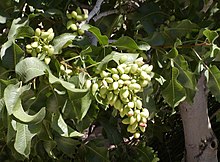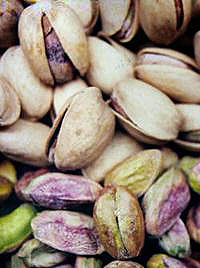| Pistacia vera | |
|---|---|

| |
| Pistacia vera Kerman fruits ripening | |
| Scientific classification | |
| Kingdom: | |
| (unranked): | |
| (unranked): | |
| (unranked): | |
| Order: | |
| Family: | |
| Genus: | |
| Species: | P. vera
|
| Binomial name | |
| Pistacia vera | |
The pistachio (Pistacia vera L., Anacardiaceae or sometimes Pistaciaceae) is a small tree native to mountainous regions of Iran, Turkmenistan, Turkey and western Afghanistan, that produces an important culinary nut. Pistacia vera often is confused with other species in the genus Pistacia that are also known as pistachio. These species can be distinguished from P. vera by their geographic distributions (in the wild) and their nuts. Their nuts are much smaller, have a strong flavor of turpentine, and have a shell that is not hard. The word pistachio is a loanword from Persian via Italian, and is a cognate to the Modern Persian word پسته Peste.
History
The modern pistachio nut (in the sense of P. vera) was first cultivated in Western Asia. Its cultivation spread into the Mediterranean world by way of central Iran, where it has long been an important crop. Although known to the Romans, the pistachio nut appears not to have reached the Mediterranean or most of the Near East in any quantity before medieval times.
More recently pistachio has been cultivated commercially in the English speaking world, in Australia, New Mexico,[1], and most notably California. The United States Department of Agriculture introduced the tree in California about 1904, but it was not promoted as a commercial crop in California until 1929.[1]
Biology
The tree grows up to 10 meters (30 ft) tall. It has deciduous pinnate leaves 10–20 centimeters (4-8 inches) long.
Pistachio is a desert plant, and is highly tolerant of saline soil. It has been reported to grow well when irrigated with water having 3,000-4,000 ppm of soluble salts.[1] Pistachio trees are fairly hardy in the right conditions, and can survive temperature ranges between −10°C (14°F) in winter to 40°C (104°F) in summer. They need a sunny position and well-drained soil. Pistachio trees do poorly in conditions of high humidity, and are susceptible to root rot in winter if they get too much water and the soil is not sufficiently free draining. Long hot summers are required for proper ripening of the fruit.
The plants are dioecious, with separate male and female trees. The flowers are apetalous and unisexual, and borne in panicles.
The fruit is a drupe, containing an elongated seed, which is the edible portion. The seed, commonly thought of as a nut, is a culinary nut, not a botanical nut. The fruit has a hard, whitish exterior shell. The seed has a mauvish skin and light green flesh, with a distinctive flavour. When the fruit ripens, the shell changes from green to an autumnal yellow/red and abruptly splits part way open (see photo). This is known as dehiscence, and happens with an audible pop. The splitting open is a trait that has been selected by humans. Commercial cultivars vary in how consistently they split open.
Each pistachio tree averages around 50 kg of nuts, or around 50,000, every two years.[2]
Cultivation
The trees are planted in orchards, and take approximately seven to ten years to reach significant production. Production is alternate bearing or biennial bearing, meaning the harvest is heavier in alternate years. Peak production is reached at approximately 20 years. Trees are usually pruned to size to make the harvest easier. One male tree produces enough pollen for eight to twelve nut-bearing females.

Pistachio trees are vulnerable to a wide variety of diseases (see List of pistachio diseases). Notable among these is infection by the fungus Botryosphaeria. This fungus causes panicle and shoot blight (ie, kills flowers and young shoots), and can damage entire pistachio orchards.
In California almost all female pistachio trees are the cultivar 'Kerman'. A sprig from a mature female Kerman is grafted onto a one year old rootstock. Male pistachios may be a different variety.
Bulk container shipments of pistachio nuts are prone to self heating and spontaneous combustion because of their high fat and low water content.[3]

| Country | Share of 2005 production[4] (tonnes) |
|---|---|
| Iran | 190 000 |
| United States | 140 000 |
| Turkey | 60 000 |
| Syria | 60 000 |
| China | 34 000 |
| Greece | 9 500 |
| Italy | 2 400 |
| Uzbekistan | 1 000 |
| Tunisia | 800 |
| Pakistan | 300 |
| Madagascar | 160 |
| Kyrgyzstan | 100 |
| Morocco | 50 |
| Cyprus | 15 |
| Mexico | 7 |
| Mauritius | 5 |
Uses
| Nutritional value per 100 g (3.5 oz) | |
|---|---|
| Energy | 2,391 kJ (571 kcal) |
27.65 g | |
| Sugars | 7.81 g |
| Dietary fiber | 10.3 g |
45.97 g | |
21.35 g | |
| Vitamins | Quantity %DV† |
| Thiamine (B1) | 70% 0.84 mg |
| Riboflavin (B2) | 12% 0.158 mg |
| Niacin (B3) | 9% 1.425 mg |
| Pantothenic acid (B5) | 10% 0.513 mg |
| Vitamin B6 | 75% 1.274 mg |
| Folate (B9) | 13% 50 μg |
| Vitamin C | 3% 2.3 mg |
| Minerals | Quantity %DV† |
| Calcium | 8% 110 mg |
| Iron | 23% 4.2 mg |
| Magnesium | 29% 120 mg |
| Phosphorus | 39% 485 mg |
| Potassium | 35% 1042 mg |
| Zinc | 21% 2.3 mg |
| †Percentages estimated using US recommendations for adults,[5] except for potassium, which is estimated based on expert recommendation from the National Academies.[6] | |
The kernels are often eaten whole, either fresh or roasted and salted, and are also used in ice cream and confections such as baklava and cold cuts such as mortadella. Lutherans in the American Midwest make pistachio salad, which includes fresh pistachios or pistachio pudding, cool whip, canned fruit and sometimes cottage cheese or marshmallows.[7] In July 2003, the Food and Drug Administration (FDA) approved the first qualified health claim specific to nuts lowering the risk of heart disease: "Scientific evidence suggests but does not prove that eating 1.5 ounces (42.5g) per day of most nuts, such as pistachios, as part of a diet low in saturated fat and cholesterol may reduce the risk of heart disease".[8]
In research at Pennsylvania State University, pistachios in particular significantly reduced levels of low-density lipoprotein (LDL cholesterol) while increasing antioxidant levels in the serum of volunteers.[9] In rats, consumption of pistachios as 20% of daily caloric intake increased beneficial high-density lipoprotein (HDL cholesterol) without lowering LDL cholesterol, and while reducing LDL oxidation.[10]
In December 2008, Dr. James Painter, a behavioral eating expert professor and chair of School of Family and Consumer Sciences at Eastern Illinois University, described the Pistachio Principle. The Pistachio Principle describes methods of "fooling" your body into eating less. One example used is that the act of de-shelling and eating pistachios one by one slows your consumption allowing you to feel full faster after having eaten less.[11]
 |
 |
The shell of the pistachio is naturally a beige color, but it is sometimes dyed red or green in commercial pistachios. Originally the dye was applied by importers to hide stains on the shells caused when the nuts were picked by hand. However most pistachios are now picked by machine and the shells remain unstained, making dyeing unnecessary (except that some consumers have been led to expect colored pistachios). Roasted pistachio nuts can be artificially turned red if they are marinated prior to roasting in a salt and strawberry marinade, or salt and citrus salts.
References
- ^ a b c Esteban Herrera (1997) Growing pistachios in New Mexico New Mexico State University, Cooperative Extension Service, Circular 532 [1]
- ^ Nugent, Jeff (2005-03-30). "Pistachio Nuts". Permaculture Plants: A Selection. Permanent Publications. p. 41. ISBN 978-1856230292.
((cite book)):|access-date=requires|url=(help); External link in|chapterurl=|chapterurl=ignored (|chapter-url=suggested) (help); Unknown parameter|coauthors=ignored (|author=suggested) (help) - ^ "13.6 Risk factor Self-heating/Spontaneous combustion". Container Handbook. GDV. Retrieved 2008-06-17.
- ^ a b "Major Food and Agricultural Commodities and Producers: 2005 Pistachios". Food and Agriculture Organization. Retrieved 2008-06-18.
- ^ United States Food and Drug Administration (2024). "Daily Value on the Nutrition and Supplement Facts Labels". FDA. Archived from the original on 2024-03-27. Retrieved 2024-03-28.
- ^ National Academies of Sciences, Engineering, and Medicine; Health and Medicine Division; Food and Nutrition Board; Committee to Review the Dietary Reference Intakes for Sodium and Potassium (2019). Oria, Maria; Harrison, Meghan; Stallings, Virginia A. (eds.). Dietary Reference Intakes for Sodium and Potassium. The National Academies Collection: Reports funded by National Institutes of Health. Washington, DC: National Academies Press (US). ISBN 978-0-309-48834-1. PMID 30844154. Archived from the original on 2024-05-09. Retrieved 2024-06-21.
- ^ http://www.recipesource.com/fgv/salads/18/rec1881.html
- ^ Office of Nutritional Products, Labeling and Dietary Supplements (2003-07-23). "Qualified Health Claims: Letter of Enforcement Discretion - Nuts and Coronary Heart Disease (Docket No 02P-0505)". Center for Food Safety and Applied Nutrition. Retrieved 2008-06-17.
- ^ Kay, Colin D (2007). "Pistachios reduce serum oxidized LDL and increase serum antioxidant levels". The FASEB Journal. 21 (6): A1091-a. Retrieved 2008-06-18.
((cite journal)): Unknown parameter|coauthors=ignored (|author=suggested) (help); Unknown parameter|month=ignored (help)
Related news articles:- "Pistachios May Calm Acute Stress Reaction". ScienceDaily. 2007-05-01. Retrieved 2008-06-17.
- "Pistachios lower risk of heart disease". Telegraph News. Telegraph Media Group Limited. 2007-05-02. Retrieved 2008-06-17.
- ^ Aksoy N, Aksoy M, Bagci C, Gergerlioglu HS, Celik H, Herken E, Yaman A, Tarakcioglu M, Soydinc S, Sari I, Davutoglu V (2007). "Pistachio intake increases high density lipoprotein levels and inhibits low-density lipoprotein oxidation in rats" (HTML). The Tohoku Journal of Experimental Medicine. 212 (1): 43–48. PMID 17464102.
((cite journal)): CS1 maint: multiple names: authors list (link) - ^ The Pistachio Principle
